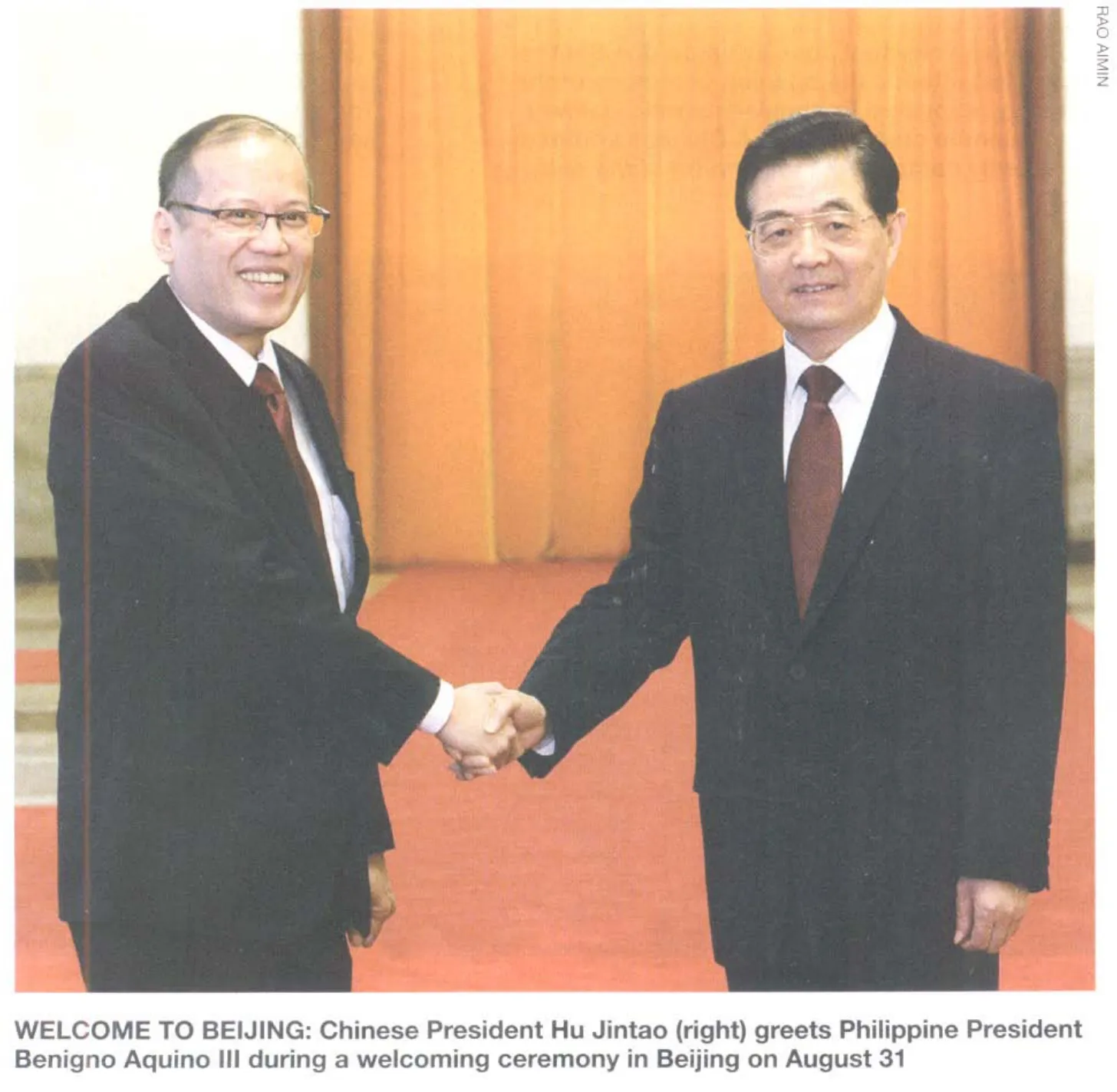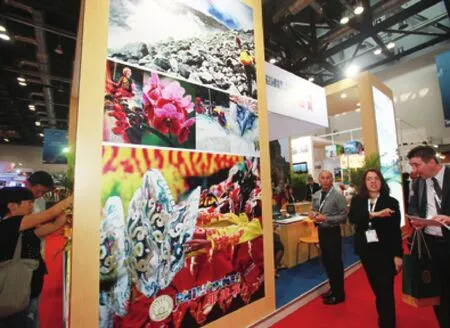Cooperation Beats Conflict
2011-10-14ByDINGYING
By DING YING
Cooperation Beats Conflict
By DING YING

China and the Philippines agree to strengthen economic and trade cooperation while minimizing disputes
Philippine President Benigno Aquino III recently completed a five-day visit to China, his first state visit to China since he took office last year. The two countries reached consensus on promoting all-round cooperation, especially in trade and the economy, and downplayed disputes in the South China Sea.
Economy first
Aquino’s delegation included nearly 300 businesspeople looking for opportunities in China. During the fi ve days, the two sides signed nine agreements, including a fi ve-year plan on bilateral economic and trade cooperation and agreements on tourism, sports and media cooperation.
“Many sectors of the two economies are reciprocal, but their business circles,as well as the two peoples, can achieve win-win results only by enhancing mutual understanding,” said Zhang Xuegang,a researcher specializing in Southeast Asian studies with the China Institutes of Contemporary International Relations(CICIR).
“It’s a set policy of the Chinese Government to consistently consolidate and develop strategic and cooperative relations with the Philippines,” said Chinese President Hu Jintao. He also suggested the two states tap into their potential and expand cooperation in sectors such as trade, infrastructure,agriculture, hydro-facilities, new energy,renewable energy and fi nance.
“We both should expand friendly exchanges between the two peoples through various means and channels to establish a good atmosphere for the development of bilateral ties,” Hu said.
He also promised China will further its cooperation with the Association of Southeast Asian Nations (ASEAN) in various sectors, including economy, finance,communications, transportation, sustainable development, social development and cultural exchanges.
Aquino said his country would be willing to work together with China and boost cooperation in different aspects to promote bilateral strategic cooperation aimed at peace and development. He said the two sides could increase investment and expand friendly exchanges between the two peoples.
During Aquino’s visit, the two countries also pledged to double their trade volume to $60 billion in fi ve years. Sino-Philippine trade amounted to $27.7 billion in 2010,making China the third largest trade partner of the Southeast Asian country.
“I invite the Chinese community to take part in this opportunity to invest in an emerging economic force in Southeast Asia,” said Aquino when addressing a Sino-Philippine economic and trade forum attended by government leaders and business executives from the two countries.
Former Chinese Ambassador to the Philippines Huang Guifang said Aquino’s visit was expected to help enhance mutual trust and common understanding. Huang also said the huge earthquake in Japan earlier this year and recent turbulent regional situations in Central, East and North African countries had greatly hurt the Philippine economy.
Japan is the Philippines’ biggest of fi cial donor and its major trade partner. The turbulence in Africa drove hundreds of thousands of Philippine workers back to their homeland. Huang said Aquino hoped his visit to China would provide a much-needed economic boost.
Chen Qinghong, another expert on Southeast Asian studies with the CICIR, said the two countries should consider long-term common development as a strategic priority.He said the world is struggling for economic revival in the shadow of the European and U.S. debt crises. Therefore, both China and the Philippines face a tough task of developing their economies and improving people’s livelihoods.
By making the most of the potential for economic cooperation, the two governments can bring tangible benefits to their people,said Chen. He also said considering their close relationship as neighbors, the two sides should deal with disputes in the South China Sea in a proper way.
Disputes remain
Recently, a dispute over the South China Sea has disrupted the normal friendship and cooperation between China and the Philippines. Countries concerned could put aside their disagreements and actively explore forms of common development in the disputed territory before a fi nal solution is reached, Hu said during his meeting with Aquino.
Hu stressed China’s stance and position on the South China Sea have been consistent and explicit. “The South China Sea dispute should be resolved peacefully through consultation and negotiation between countries concerned,” he said.
Hu said China is ready to work with ASEAN countries, including the Philippines,to implement the Declaration on the Conduct of Parties in the South China Sea and jointly develop the waters into “a sea of peace,friendship and cooperation.”
In the declaration, inked by China and ASEAN members in 2002, all concerned parties pledged to maintain self-restraint and avoid activities that might complicate or escalate disputes in the region. In July this year,China and ASEAN adopted an agreement that established guidelines for implementing the declaration, marking an important step toward a peaceful solution to the disputes.
Aquino also con fi rmed his government’s stance on maintaining peace and stability in the region and implementing the declaration. The South China Sea issue does not constitute all bilateral relations, Aquino said,adding that the issue should not affect the development of friendly cooperation between the two countries.
Observers believe the positive attitudes shown by China and the Philippines will benefit both countries and help to promote bilateral trade and economic cooperation.“There is a strong political willingness from both sides to minimize the impact of the disputes on overall relations, which is good news for the two states,” said Qu Xing, President of the China Institute of International Studies.
However, many experts pointed out the two sides eventually should find a way to settle the disputes in the South China Sea.Ye Hailin, a researcher with the Chinese Academy of Social Sciences, said further economic cooperation in oil and natural gas exploitation will inevitably touch the disputed areas.
During the administration of Maria Gloria Macapagal-Arroyo, Aquino’s predecessor, China, Viet Nam and the Philippines reached an agreement on joint exploitation in the disputed region. But the Philippines quit the agreement due to pressure from Australia and the United States.
The Nansha Islands in the South China Sea have long been acknowledged as Chinese territory. Since the early 1970s after the region was found to be rich in oil and other natural resources, however, Southeast Asian countries including the Philippines, Viet Nam, Malaysia and Brunei have claimed sovereignty over all or part of the islands.
Ye said despite China’s appeals for joint exploitation, the Philippines is unlikely to give up its sovereignty claims. He said that the two sides’ agreement to minimize disputes at least proved that the South China Sea issue does not represent all aspects of the bilateral relationship.
Besides Beijing, Aquino also visited Shanghai and southeast China’s Fujian Province. His mother, former Philippine President Corazon Aquino, was a fourthgeneration Chinese Filipino. Her greatgrandfather, who arrived in the Philippines in 1861, was a villager in Fujian.
Zhang Xuegang from the CICIR said that by visiting the hometown of his mother’s family, Aquino helped promote mutual trust by stressing the two countries’ historical and cultural ties, which can be traced back hundreds of years. Zhang believes the geographic, historic,cultural and even blood bonds between the two nations will strongly in fl uence the future development of their relations.
“The two sides should put the South China Sea issue in a proper position, and then settle the issue in a peaceful manner,”Zhang said.

PROMOTING TOURISM:Visitors pass by the Philippines’ pavilion at the China International Travel Mart 2011 in Beijing on August 30
